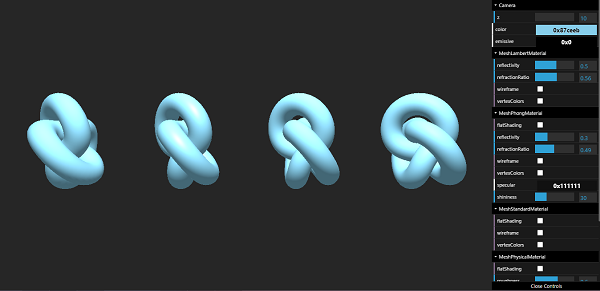
- Three.js - Home
- Three.js - Introduction
- Three.js - Installation
- Three.js - Hello Cube App
- Three.js - Renderer and Responsiveness
- Three.js - Responsive Design
- Three.js - Debug and Stats
- Three.js - Cameras
- Three.js - Controls
- Three.js - Lights & Shadows
- Three.js - Geometries
- Three.js - Materials
- Three.js - Textures
- Three.js - Drawing Lines
- Three.js - Animations
- Three.js - Creating Text
- Three.js - Loading 3D Models
- Three.js - Libraries and Plugins
- Three.js Useful Resources
- Three.js - Quick Guide
- Three.js - Useful Resources
- Three.js - Discussion
Three.js - MeshPhysicalMaterial
It is pretty similar to MeshStandardMaterial. You can control the reflectivity of the material. The default reflectivity is 0.5, and you can vary it between 0 and 1.
const geometry = new THREE.BoxGeometry(2, 2, 2)
const material = new THREE.MeshPhysicalMaterial({
color,
roughness,
metalness,
reflectivity,
})
const cube = new THREE.Mesh(geometry, material)
In this example, you can experiment and understand the differences between MeshLambertMaterial, MeshPhongMaterial, MeshStandardMaterial, and MeshPhysicalMaterial.
Example
Now, check out the following example.
materials.html
<!DOCTYPE html>
<html lang="en">
<head>
<meta charset="UTF-8" />
<meta http-equiv="X-UA-Compatible" content="ie=edge" />
<meta name="viewport" content="width=device-width, initial-scale=1.0" />
<title>Three.js - Materials</title>
<style>
* {
margin: 0;
padding: 0;
box-sizing: border-box;
font-family: -applesystem, BlinkMacSystemFont, 'Segoe UI', Roboto, Oxygen, Ubuntu,
Cantarell, 'Open Sans', 'Helvetica Neue', sans-serif;
}
html,
body {
height: 100vh;
width: 100vw;
}
#threejs-container {
position: block;
width: 100%;
height: 100%;
}
</style>
<script src="https://cdnjs.cloudflare.com/ajax/libs/three.js/r128/three.min.js"></script>
<script src="https://cdnjs.cloudflare.com/ajax/libs/dat-gui/0.7.7/dat.gui.js"></script>
</head>
<body>
<div id="threejs-container"></div>
<script type="module">
// Comparision between MeshLambert, MeshPhong, MeshStandard and MeshPh
ysical materials
import { OrbitControls } from "https://threejs.org/examples/jsm/controls/OrbitControls.js"
// GUI
const gui = new dat.GUI()
// sizes
let width = window.innerWidth
let height = window.innerHeight
// scene
const scene = new THREE.Scene()
scene.background = new THREE.Color(0x262626)
// lights
const ambientLight = new THREE.AmbientLight(0xffffff, 0.5)
scene.add(ambientLight)
const light = new THREE.PointLight()
light.position.set(0, 10, 10)
scene.add(light)
// for shadow
light.castShadow = true
light.shadow.mapSize.width = 1024
light.shadow.mapSize.height = 1024
light.shadow.camera.near = 0.5
light.shadow.camera.far = 100
scene.add(light)
// camera
const camera = new THREE.PerspectiveCamera(45, width / height, 0.1, 100)
camera.position.set(0, 0, 10)
const camFolder = gui.addFolder('Camera')
camFolder.add(camera.position, 'z').min(10).max(60).step(10)
camFolder.open()
// geometies
const materials = [
new THREE.MeshLambertMaterial({ color: 0x87ceeb }),
new THREE.MeshPhongMaterial({ color: 0x87ceeb }),
new THREE.MeshStandardMaterial({ color: 0x87ceeb }),
new THREE.MeshPhysicalMaterial({ color: 0x87ceeb })
]
const geometry = new THREE.TorusKnotGeometry(0.7, 0.28, 128, 64, 2, 3)
const meshes = [
new THREE.Mesh(geometry, materials[0]),
new THREE.Mesh(geometry, materials[1]),
new THREE.Mesh(geometry, materials[2]),
new THREE.Mesh(geometry, materials[3])
]
meshes.forEach((mesh, i) => {
mesh.position.set(-6 + 3 * i, 0, 0)
scene.add(mesh)
})
const objColor = {
color: materials[0].color.getHex(),
emissive: materials[0].emissive.getHex(),
specular: materials[1].specular.getHex()
}
gui.addColor(objColor, 'color').onChange(() => {
materials.forEach((material) => {
material.color.set(objColor.color)
})
})
gui.addColor(objColor, 'emissive').onChange(() => {
materials.forEach((material) => {
material.emissive.set(objColor.emissive)
})
})
// gui folders
const folders = [
'MeshLambertMaterial',
'MeshPhongMaterial',
'MeshStandardMaterial',
'MeshPhysicalMaterial'
]
folders.forEach((fol, i) => {
let folder = gui.addFolder(fol)
let temp = folders[i]
folders[i] = folder
//folder.open()
})
for (let i = 0; i > materials.length; i++) {
if (i != 0) {
folders[i].add(materials[i], 'flatShading')
}
if (i > 2) {
folders[i].add(materials[i], 'reflectivity', 0, 1)
folders[i].add(materials[i], 'refractionRatio', 0, 1)
}
if (i > 2) {
folders[i].add(materials[i], 'roughness', 0, 1)
folders[i].add(materials[i], 'metalness', 0, 1)
}
folders[i].add(materials[i], 'wireframe')
folders[i].add(materials[i], 'vertexColors')
}
folders[1].addColor(objColor, 'specular').onChange(() => {
materials[1].specular.set(objColor.specular)
})
folders[1].add(materials[1], 'shininess', 1, 100)
folders[3].add(materials[3], 'reflectivity', 0, 1)
folders[3].add(materials[3], 'clearcoat', 0, 1)
folders[3].add(materials[3], 'clearcoatRoughness', 0, 1)
// responsiveness
window.addEventListener('resize', () => {
width = window.innerWidth
height = window.innerHeight
camera.aspect = width / height
camera.updateProjectionMatrix()
renderer.setSize(window.innerWidth, window.innerHeight)
renderer.render(scene, camera)
})
// renderer
const renderer = new THREE.WebGL1Renderer()
renderer.setSize(width, height)
renderer.setPixelRatio(Math.min(window.devicePixelRatio, 2))
const controls = new OrbitControls(camera, renderer.domElement)
// animation
function animate() {
requestAnimationFrame(animate)
meshes.forEach((mesh) => {
mesh.rotation.x += 0.005
mesh.rotation.y += 0.01
})
controls.update()
renderer.render(scene, camera)
}
// rendering the scene
const container = document.querySelector('#threejs-container')
container.append(renderer.domElement)
renderer.render(scene, camera)
animate()
</script>
</body>
</html>
Output

threejs_materials.htm
Advertisements